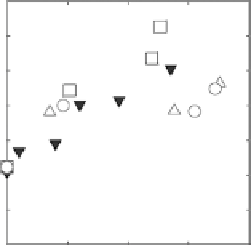Biomedical Engineering Reference
In-Depth Information
70
60
50
40
30
20
10
0
0
20
Adsorbed amount (mg/g)
40
60
80
Figure 5.17
Improvement in tensile index for sheets made from PEM-treated fibres with
differentchemicalcombinations. FilledtrianglesshowlowmolecularmassPAH/PAAwitha
7.5/3.5pHstrategy, unfilled triangles showanionicpotatostarchandcationicpotatostarch
withaD.S. (DegreeofSubstitution)of0.06,unfilledsquaresshowanionicpotatostarchand
cationicamylose-rich starch frompotatobothwithaD.S.
0.06andunfilledcircles show
anionicpotatostarchandcationicamylopectinstarchfrompotatobothwithaD.S. of 0.06.
Fullybleached,unbeatenchemical softwoodfibreswereusedinall theexperimentsandall
thesheetswerepreparedwithabackgroundNaClconcentrationof0.01M(48).
=
5.6
Influence of PEM on Adhesion between Surfaces
As was indicated earlier, based on long-term experience with fibre networks, it is almost
impossible to identify the molecular mechanisms responsible for the differences between
different chemical systems simply by testing fibre network properties. To identify
the molecular reasons for the detected differences, more clear-cut model experiments
are needed where the methods used have a sensitivity and geometrical resolution that
permit differentiation between different mechanisms. This has been done in earlier,
nonfibre-related investigations regarding the formation of adhesive joints between poly-
mer surfaces (49). In this investigation (49), it was shown that a diblock co-polymer
A-B added to the interface of blocks of A and B can dramatically improve the adhesion
between the polymers A and B via a mechanical entanglement (49) of molecular chains
on the two sides of the interface by the co-polymer. The number of chains interacting,
as well as the length of the chains, influences the fracture toughness of the joint formed
between the polymers. Translated into the interaction between PEMs formed on fibres,
this suggests that the number of chains, and the length of the chains, indirectly deter-
mined by the molecular mass (50) of the polymers at a certain adsorbed amount, may
control the adhesion between the layers. However, this hypothesis has to be tested in
model experiments before any further conclusions can be drawn.
The QCM-D experiments, described earlier, are one type of model experiment
that can be used to test the hypothesis of molecular mobility. A PEM formed from
PAH/PAA (19) showed a higher dissipation measured by QCM than PEMs formed from
PDADMAC/PSS (46), indicating a less rigid structure with a larger number of chain
ends and loops in the PAH/PAA interacting to give a stronger adhesion. The dissipation

Search WWH ::

Custom Search